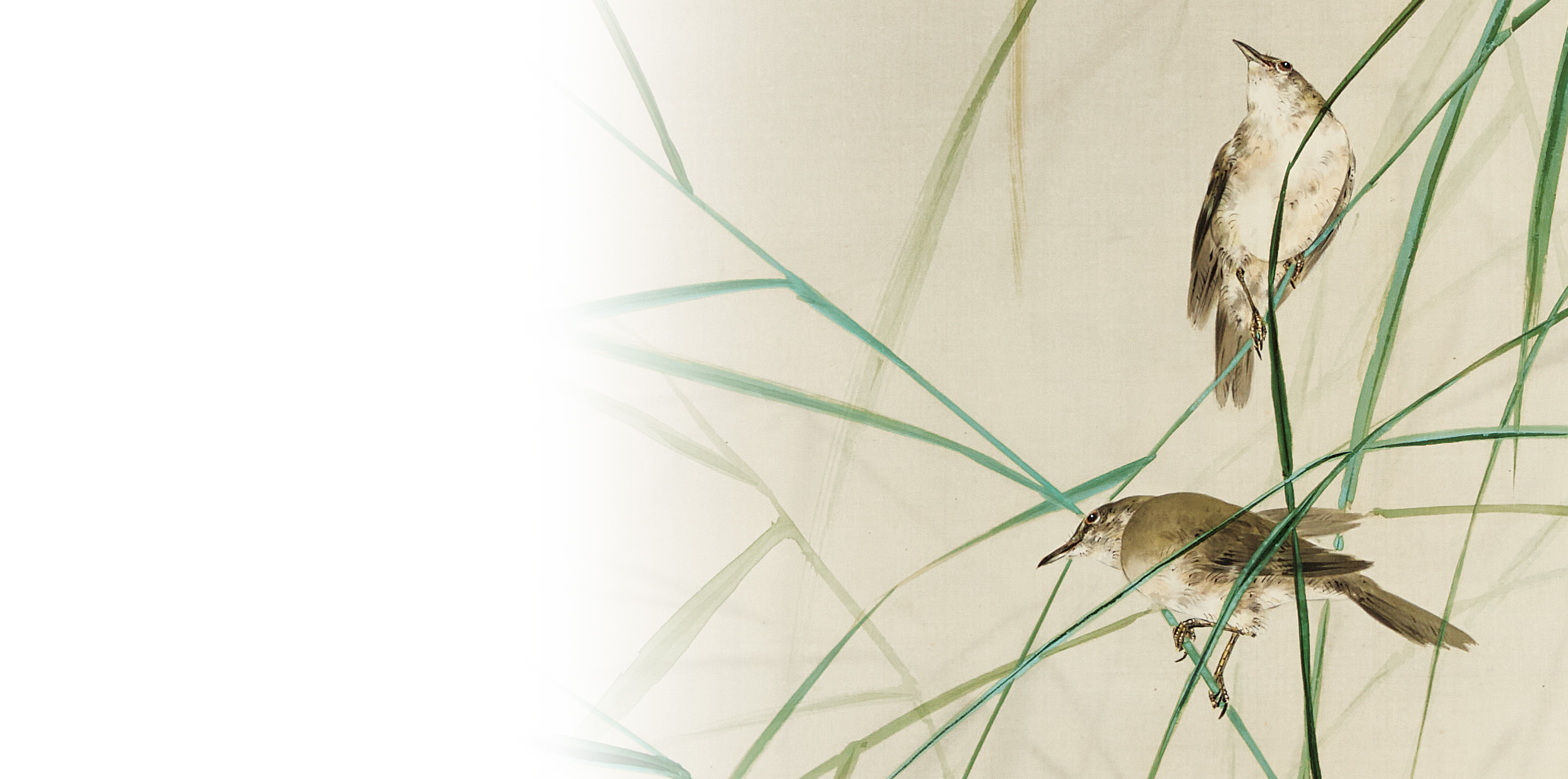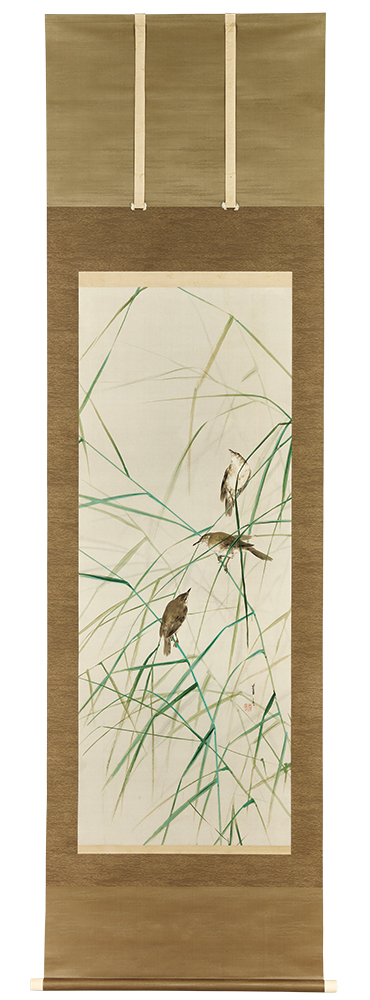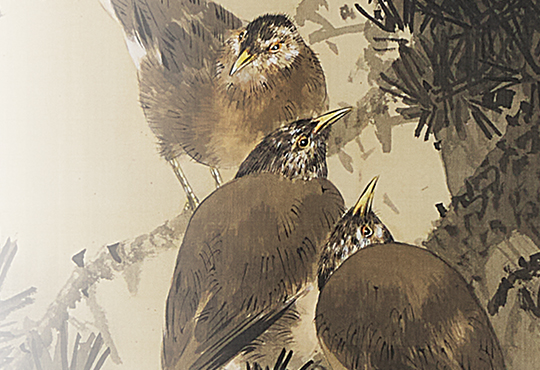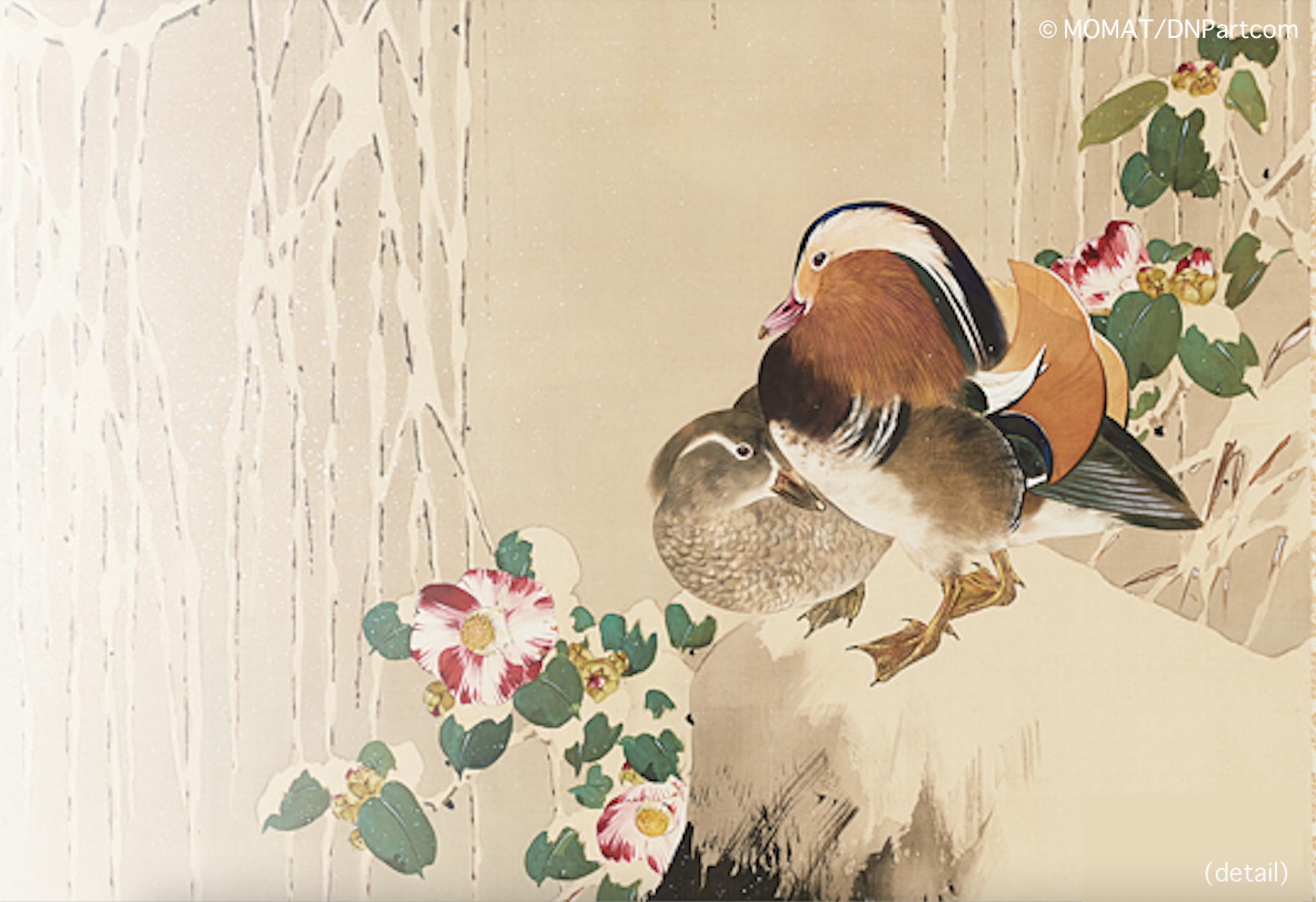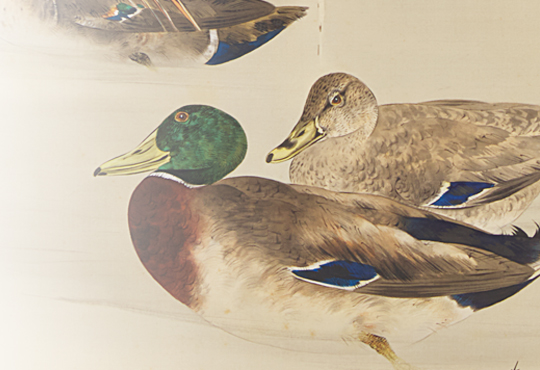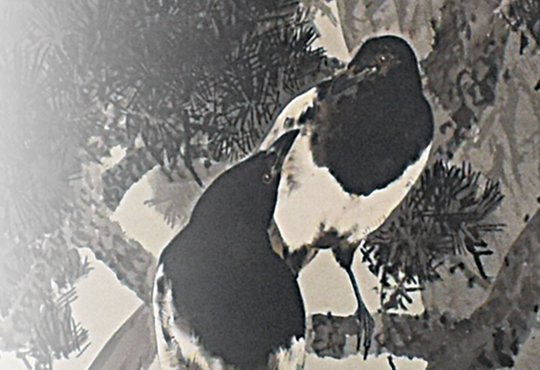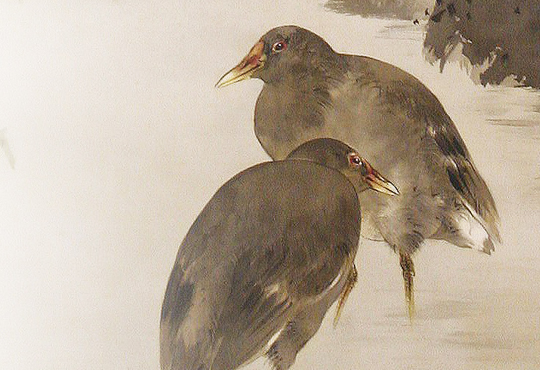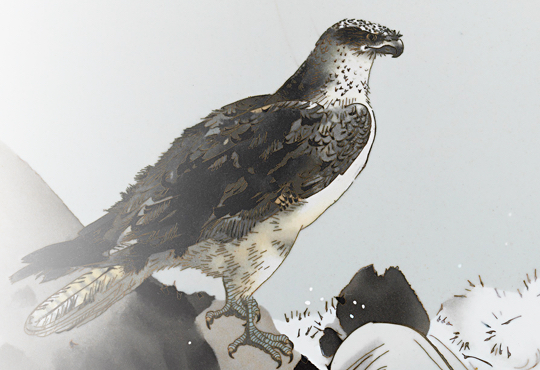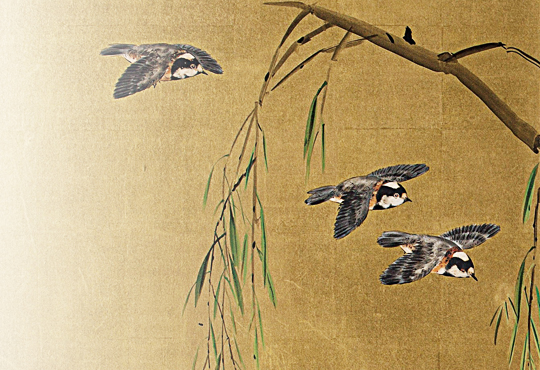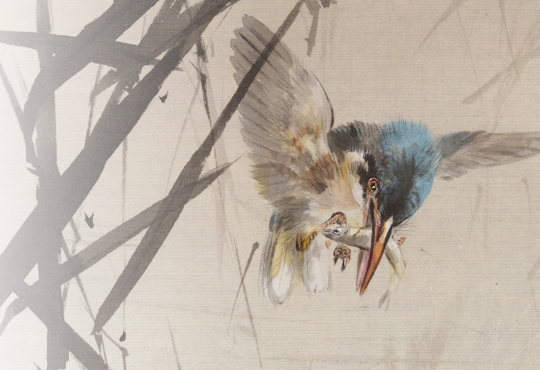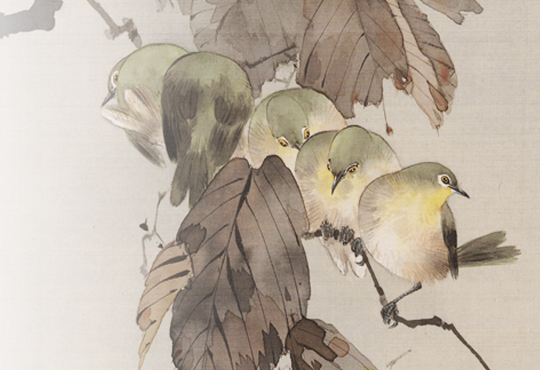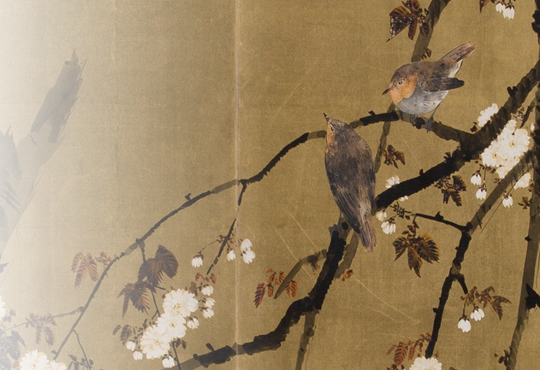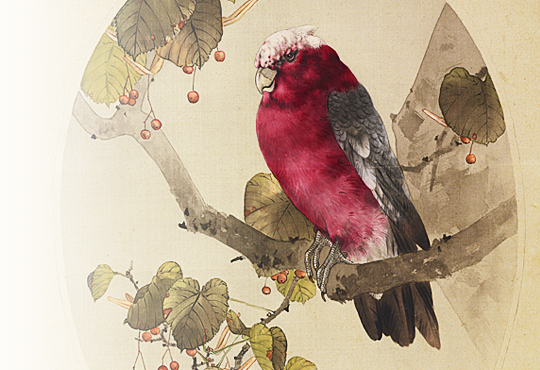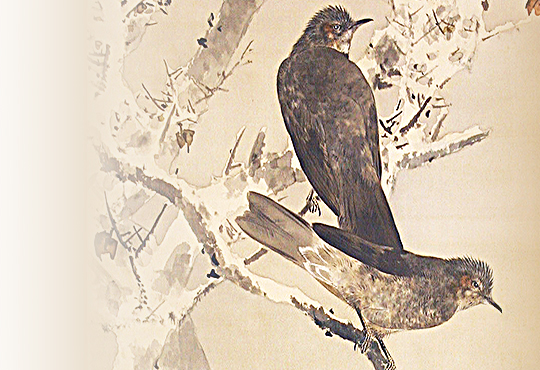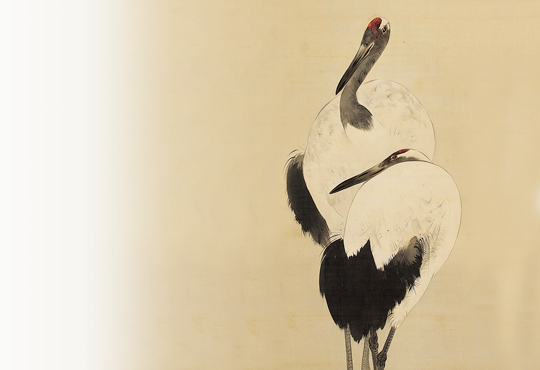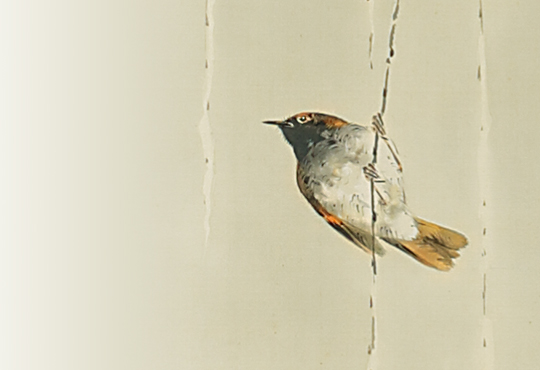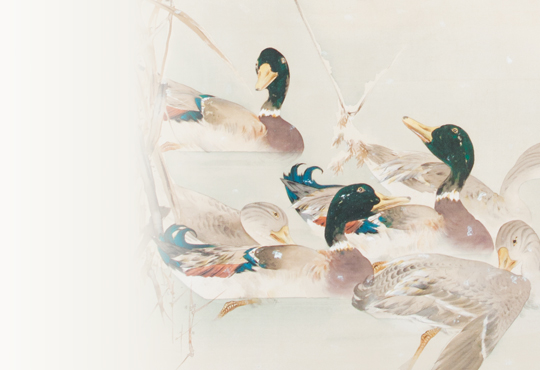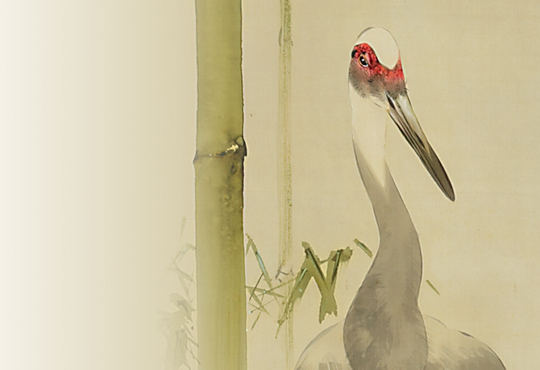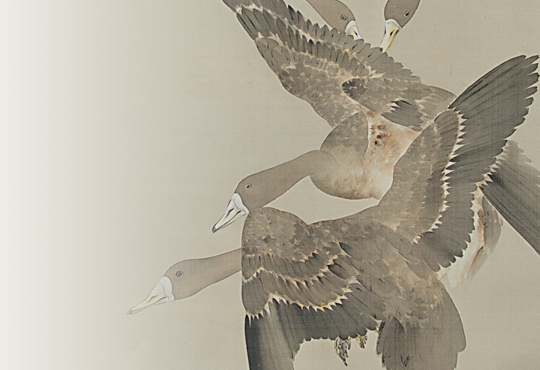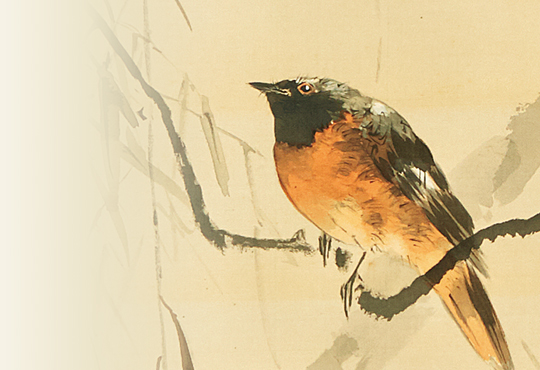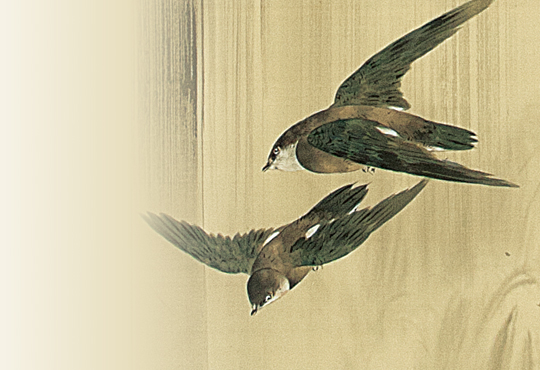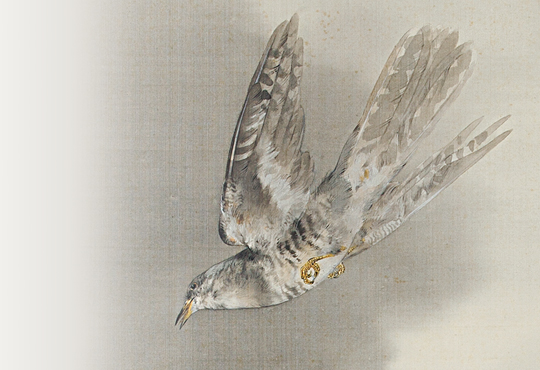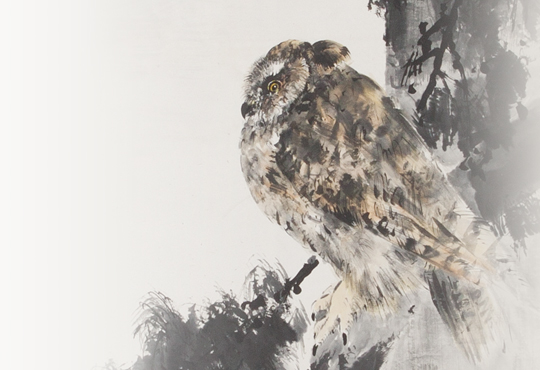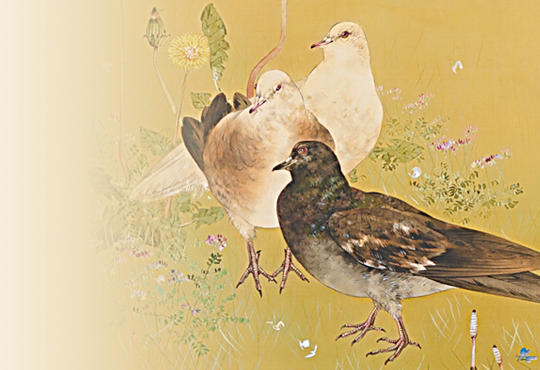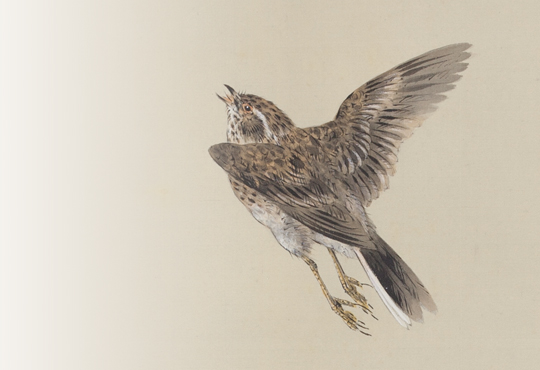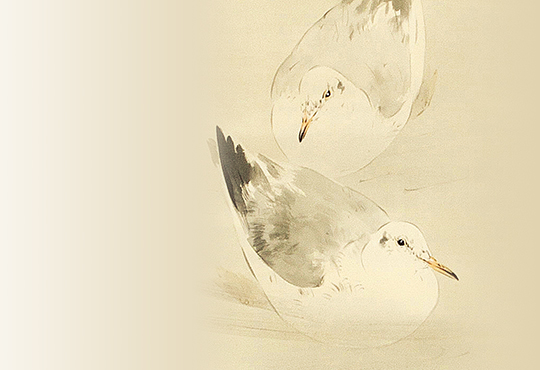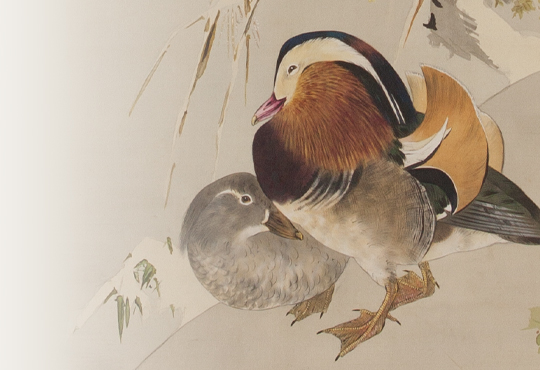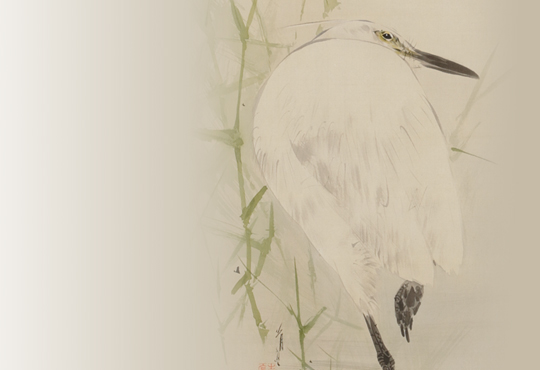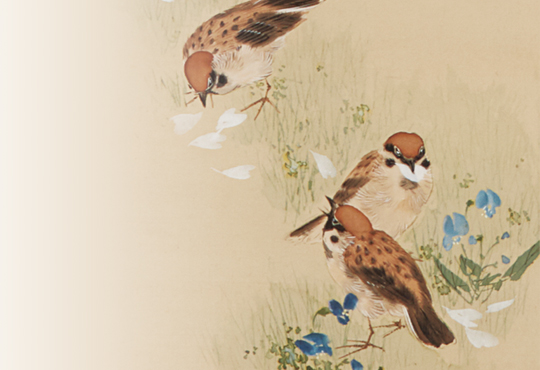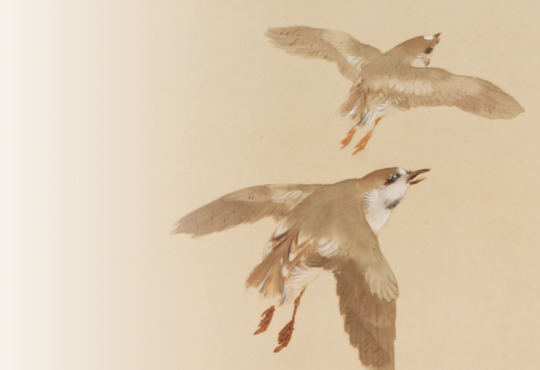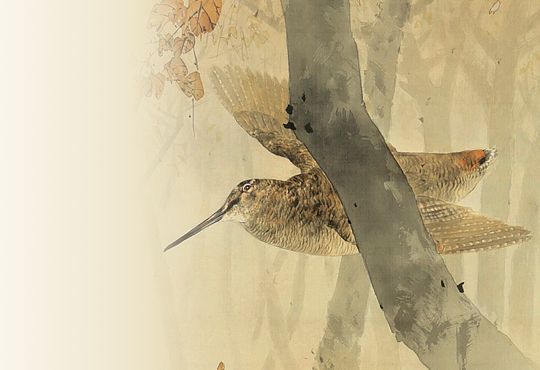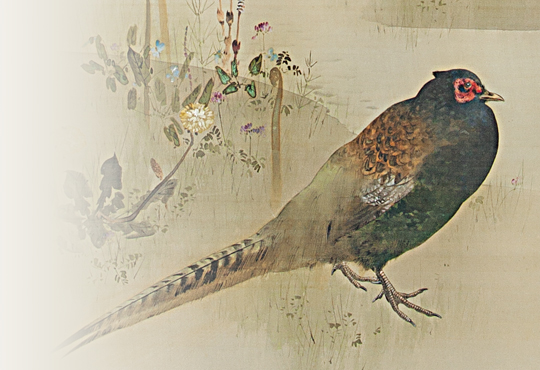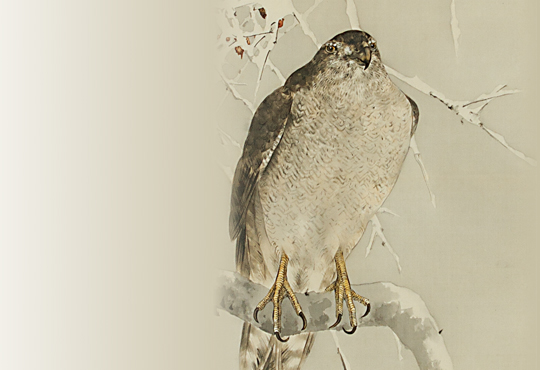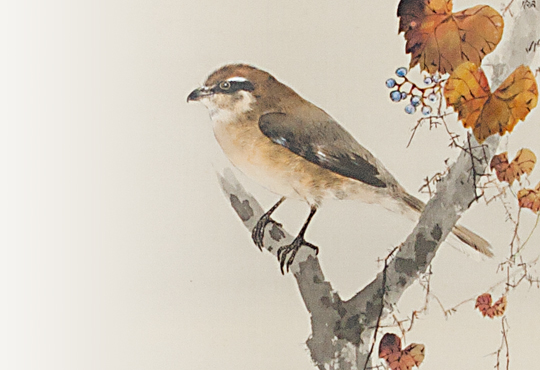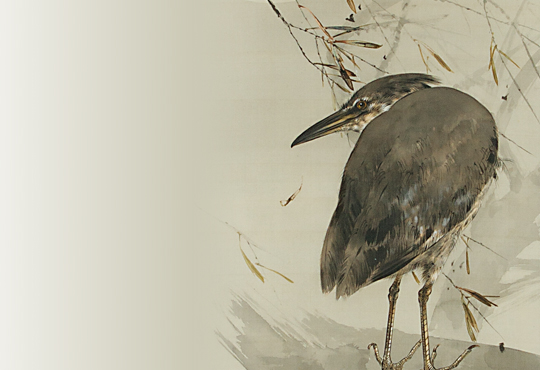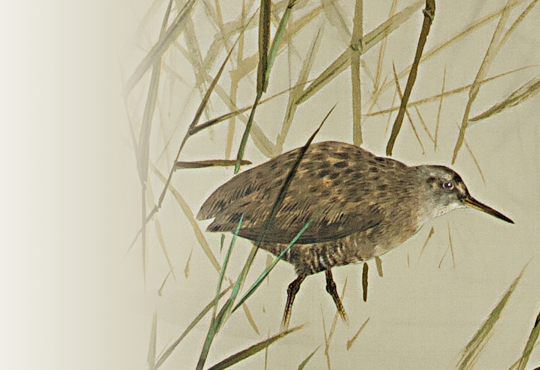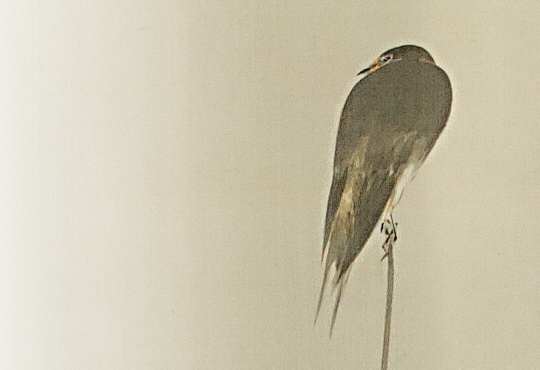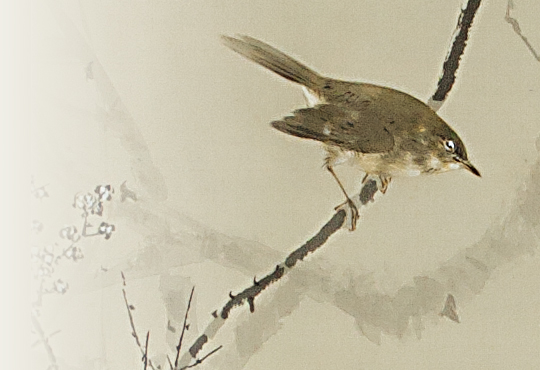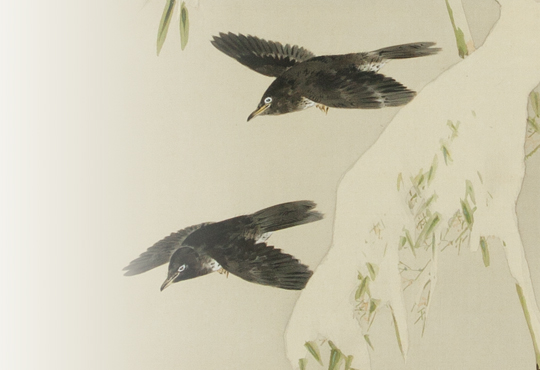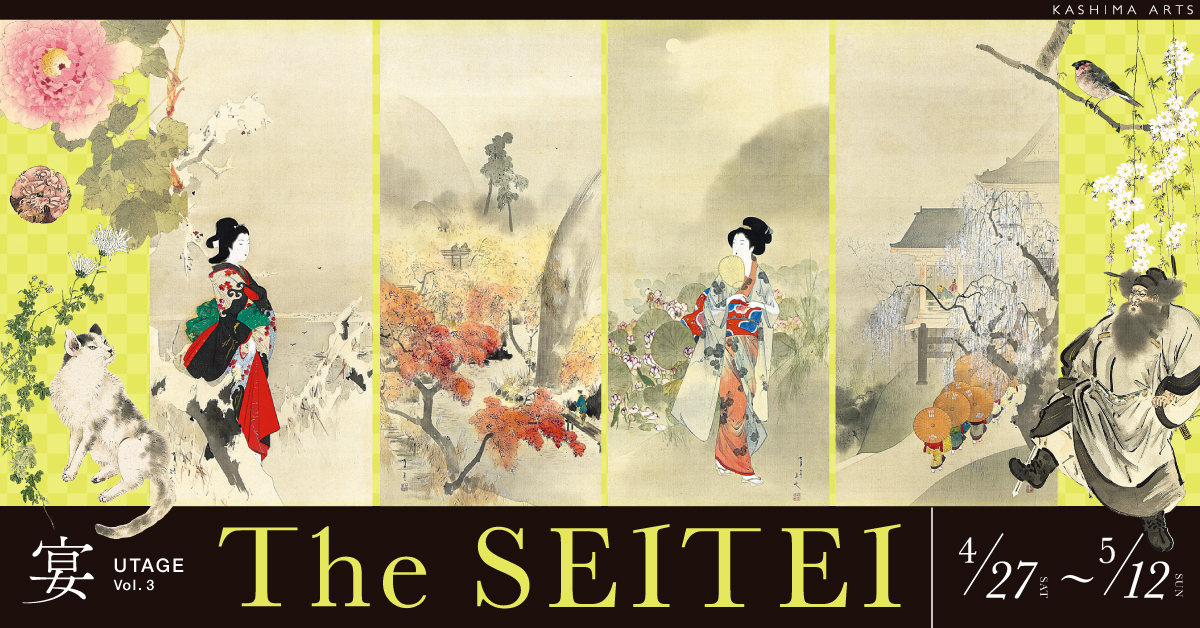Color on silk, with a box signed and sealed by the artist, futai and ichimonji with artist seal design
130×49㎝ / 227×65㎝
vol.38|Special Edition The Game of Love: Gyogyoshi (Reed Warbler)
The bird I had been waiting for has finally appeared in front of me.
In the “Kacho no Ma” (Hall of Flowers and Birds) of the State Guest House, Akasaka Palace, Tokyo, there are 30 oval cloisonné medallions with flowers and birds painted by Seitei and made by Namikawa Sosuke (introduced in detail in Vol.27 of this column). It is Seitei’s largest public project, and of course, most famous. Each medallion depicts a different bird and includes most of the species introduced in this series so far. Conversely, there are several birds that can be seen only in these cloisonné medallions, which I find very strange. It is hard to imagine the bird-loving Seitei would satisfy with just sketches for cloisonné medallions. I always thought that these birds would appear in other works sometime, somewhere. Finally, the work I had long-awaited has appeared in front of me.
The Reed Warbler (body length 18cm) in this work is a common summer bird that lives in reed fields throughout Japan, and we can often see males chirping on the tip of reeds in early summer. It’s appearance is quite plain and ordinary with light brown feathers, but the loud chirp that sounds like “Gyogyoshi, gyogyoshi, kirikiri” and its bright red beak make them quite unique. Japanese common name, Gyogyoshi, comes from this chirp. Another characteristic of the Reed Warbler is that it is polygamous, which is very rare in birds. Females are responsible for everything from nesting to raising chicks, while males only help carry food to the chicks. The bird is quite one-of-a-kind despite its plain appearance.
In this work, three Reed Warblers are perching on a lush reed bush. The reeds are green and soft, so the season is probably early summer. Perched on soft stems, they have relatively long beaks, legs, and tails, grayish-brown backs, whitish chests and bellies, distinct eyebrow spots above the eyes, and some bristles at the bottom of their beaks. As usual, Seitei’s depiction is very precise. I would always take my hat off to him for his remarkable skill in depicting the firmness of the flight feathers, the suppleness of the tail feathers, and the softness of the body feathers. What I would like you to pay attention to is the depiction of the feet and claws that grasp the reeds. Reed Warbler’s toes have surprisingly strong grip, and the claws are large and sharp. I sometimes capture Reed Warbler in my academic research, and when the claws dig in my skin with its strong grip, it is very painful. Unlike any of the small birds, Reed Warbler’s claws are so big, and Seitei depicts them quite accurately with their toes wrapping around the reed stems. The Reed Warblers in the cloisonné medallions of the Akasaka Palace are also depicted with three birds, with similar figures and poses but the composition is slightly different.
Now, what is the relationship between these three birds? Of the three birds, the one on the lower left is slightly smaller and distant from the other two. Presumably, this one is female and the other two are males. Let’s take a look at the gaze of the three birds. The male in the upper right is looking towards upper left, the male in the middle is in a left side posture with his eyes turned upward, and the female in the lower left is looking at the upper right, which means the middle one is looking at the bird on the upper right and the one on the bottom left is looking at the other two. By the their gaze, the male→ male, and female → two males, the two males are in the middle of a fight and the female is observing them. Presumably, this is a scene where a single female appears near the border of the territories, and the males are fighting over the female knowing that she is comparing and evaluating them. I believe that this is a passionate work that depicts such a love affair.
Once a person knows something, he cannot return to his previous feelings. The first impression of this work would have been a quiet one with very little movement, but after discovering about the love affair, it only appears tense and passionate. The love story of the Reed Warbler, which is repeated every year in reed fields all over Japan, is forever captured in this serene painting by Seitei.
Author : Masao Takahashi Ph.D. (Ornithologist)
Dr. Masao Takahashi was born 1982 in Hachinohe (Aomori prefecture) and graduated from Rikkyo University’s Graduate School of Science. Dr. Takahashi specializes in behavioral ecology and the conservation of birds that inhabit farmlands and wet grasslands. Focusing on the relation between birds and art, he has participated in various museum and gallery talks.
“Reed Warbler” (Gyogyoshi) is currently on display at Japanese Art Auction MEGURU Vol.16.
For details, please click here.
You can also view the work in person at the Kashima Arts gallery from November 18 (Sat) to November 26 (Sun), so please feel free to drop in!
【Event Outline】 Japanese Art Auction Vol.16 Preview: November 18 (Sat) to November 26 (Sun), 2023 Free admission / Open daily Hours: 10:00-18:00 Bidding deadline: November 26 (Sun), 2023, 6pm JST Results: November 28 (Tue), 2023, 3pm JST Exhibiting Works: Approx. 528 lots Venue: Kashima Arts 〒104-0031 3-3-2 Kyobashi, Chuo-ku, Tokyo Web: https://meguru-auction.jp/en/
